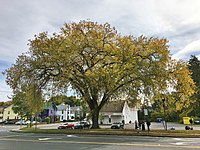
Photo from wikipedia
Abstract The increased threat of pests and pathogens in plantations has strengthened the need to understand the factors underlying their occurrence, such as climate and tree ontogenic, and the effect… Click to show full abstract
Abstract The increased threat of pests and pathogens in plantations has strengthened the need to understand the factors underlying their occurrence, such as climate and tree ontogenic, and the effect of these pests and diseases on plant performance. Spotted gums (Corymbia citriodora and C. henryi), C. torelliana, and their hybrids are important commercial plantation taxa, because they are suited to a range of environments where traditional commercial eucalypts grow poorly. They have desirable field performance and can produce a range of timber and fibre products. This study investigated field performance, ontogenetic shifts from juvenile to intermediate leaves, and damage by pests and pathogens in pure spotted gum taxa, including C. citriodora subsp. citriodora (CCC), C. citriodora subsp. variegata (CCV) and C. henryi (CH), C. torelliana (CT), and their hybrids over a two year period. The study revealed that higher mean daily rainfall and maximum/minimum temperatures positively influenced tree performance but were also associated with higher levels of defoliation by generalist insects. Necrosis associated with Quambalaria pitereka was not correlated with climatic conditions in most of the taxa. Growth rate and defoliation were positively correlated, while flushing and damage parameters (defoliation and leaf necrosis) were often negatively correlated, suggesting that the taxa studied may have high tolerance to defoliation. Ontogenetic shifts were variable between taxa, occurring earlier in pure spotted gum taxa than in hybrids. The only environmental factor related to the transition from juvenile to intermediate leaves was mean daily rainfall, suggesting that ontogenetic shifts may be associated with an adaptation to water availability. Overall, CCC and CT × CCC displayed the best combination of performance and resistance to pests and pathogens. Severe defoliation was associated with reduced diameter at breast height over bark (DBH) in CCV and CH. Tree interactions with damage and climate parameters were more consistent in the pure species than in the hybrids. These results add important knowledge on plant interactions with biotic and abiotic stress, assisting with strategies of pests and pathogen management and selection of the most appropriate taxa for pest and disease prone sites in southern Queensland.
Journal Title: Forest Ecology and Management
Year Published: 2020
Link to full text (if available)
Share on Social Media: Sign Up to like & get
recommendations!